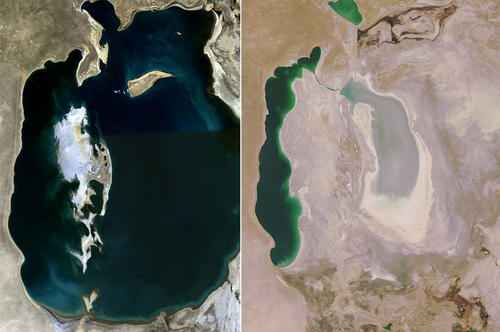When the Human Factor Takes Precedence
The end of the last major Ice Age is widely considered the most recent turning point in the Earth’s history. Geologists are now discussing whether it is time to proclaim a new era: the Anthropocene – the age of humankind.
Jun 26, 2013
Once one of the world’s largest lakes, Central Asia’s Aral Sea held a lot of water as recently as summer 1989 (left). The photo at right shows what was left of the lake in October 2008.
Image Credit: earthobservatory.nasa.gov, 1989
It must have been the early 1970s. Reinhold Leinfelder was still a schoolboy, and he had an unusual hobby: frogs, newts, salamanders, and toads. There were a lot of them in the woods to the west of Augsburg, near his home – but from one day to the next, they simply vanished. A golf course had been built in the neighborhood, and the fertilizer used for the green had destabilized local lakes.
“That was a key experience for me,” says Leinfelder, who has been a professor of paleontology and geobiology at Freie Universität Berlin since 2012. What he observed back then in the Augsburg area is still his major field of inquiry today: What influence do humans have on their environment? How strong is that influence? And is it still even reasonable to consider nature and culture separately in the first place?
“Only about a quarter of the land area of the Earth that isn’t covered by ice is in a condition that reflects less pronounced human influence,” Leinfelder says. Sicily: deforested by the Romans to supply the legions with grain. The Aral Sea: dried up to irrigate the cotton fields of the Kazakh steppes. The hole in the ozone layer: caused by humans. And Berlin’s highest elevation, the Teufelsberg: an artificial hill built on the rubble left after World War II. The Earth is increasingly shaped by human activity.
Leinfelder is a geologist. When he thinks of history, it isn’t in centuries, but millennia. And he thinks the time has come to proclaim a new geological epoch. So far, the Holocene has been considered the most recent era in the history of the Earth, starting about 10,000 BC, after the last great Ice Age. The Dutch atmospheric chemist and Nobel laureate Paul Crutzen popularized the term “Anthropocene” in the research world in 2000 – and it has been a hot-button issue among geologists ever since.
“We have to answer the question of whether human influence is so great that we can speak of a new epoch in the Earth’s history,” Leinfelder says. As for his hypothesis, Leinfelder says, “Humans are certainly a geological factor. There are sand beaches that consist of 40 percent plastic granules. We work with rare metals and rare earths that are present in concentrated amounts in very few sites on Earth, and spread them over the entire globe in mobile phones, computers, and fuel rods.” Whether the industrialization of Western Europe, the economic upturn following World War II, or even the end of nomadic life and the beginning of settled human existence in the late Neolithic should be seen as the turning point is of secondary importance, says Leinfelder. “It’s about being conscious that humans have changed the Earth to a crucial degree.”
The professor hopes the subject will not be confined to academic discussion among geologists, but instead will advance on an interdisciplinary basis. “We know how humans have unwittingly interfered with natural cycles in the past, in most cases with negative effects,” he says. “So why shouldn’t it be possible to use our knowledge to harness the power of humanity for positive aims?” Leinfelder brings together geologists and designers, architects, historians, and climate researchers. He is on the management team for the Anthropocene Project, which was launched in January at the House of World Cultures and will explore the idea of the era of human impact using scientific and artistic tools and methods until late 2014, through a series of exhibits, conferences, installations, and experiments. One of the art projects has involved roasting an ox, for example, and decoding the “flow of substances” in the grilled meat: What substances make up the meat? How much carbon dioxide was released? How much water did the ox use? How much energy was used to bring a piece of cooked meat to the plate? “We want to raise awareness of how much influence even our everyday lives have on the course of the Earth’s history.”
Schools and universities also have to do their part, Leinfelder says. “Our educational institutions are still very much organized by sector, and they are too cut off from each other. We need more links, interdisciplinary centers, and exchange. The German government’s Excellence Initiative has definitely been a big help in overcoming the boundaries of specific disciplines.” As a result, he hopes Freie Universität will host a center that brings together Earth sciences and politics, natural sciences and the humanities, where polymaths have a place and specialists can get in touch with each other: a center of Anthropocene research.
Further Information
Prof. Dr. Reinhold Leinfelder, Freie Universität Berlin, Department of Earth Sciences, Institute of Geological Sciences, Tel.: +49 30 838-70285, Email: reinhold.leinfelder@fu-berlin.de

